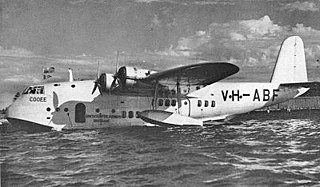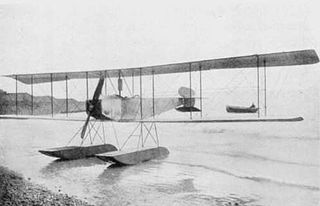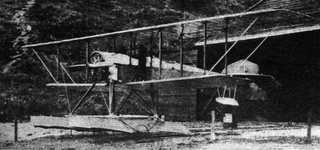
A flying boat is a type of fixed-winged seaplane with a hull, allowing it to land on water. It differs from a floatplane in that a flying boat's fuselage is purpose-designed for floatation and contains a hull, while floatplanes rely on fuselage-mounted floats for buoyancy. Though the fuselage provides buoyancy, flying boats may also utilize under-wing floats or wing-like projections extending from the fuselage for additional stability. Flying boats often lack landing gear which would allow them to land on the ground, though many modern designs are convertible amphibious aircraft which may switch between landing gear and flotation mode for water or ground takeoff and landing.

Glenn Hammond Curtiss was an American aviation and motorcycling pioneer, and a founder of the U.S. aircraft industry. He began his career as a bicycle racer and builder before moving on to motorcycles. As early as 1904, he began to manufacture engines for airships. In 1908, Curtiss joined the Aerial Experiment Association, a pioneering research group, founded by Alexander Graham Bell at Beinn Bhreagh, Nova Scotia, to build flying machines.

A seaplane is a powered fixed-wing aircraft capable of taking off and landing (alighting) on water. Seaplanes are usually divided into two categories based on their technological characteristics: floatplanes and flying boats; the latter are generally far larger and can carry far more. Seaplanes that can also take off and land on airfields are in a subclass called amphibious aircraft, or amphibians. Seaplanes were sometimes called hydroplanes, but currently this term applies instead to motor-powered watercraft that use the technique of hydrodynamic lift to skim the surface of water when running at speed.
Fabre Hydravion is the name used in English-language sources for an originally unnamed experimental floatplane designed by Henri Fabre. The aircraft is notable as the first to take off from water under its own power.

The Voisin Canard was an aircraft developed by Voisin brothers during 1910 and first flown early in 1911. It was named the Canard because of the resemblance of its forward fuselage to that of a duck's long neck while in flight. It was originally flown as a landplane: with the addition of floats it became one of the first seaplanes used by the French Navy.

The Avro Type 584 Avocet was a British single-engined naval fighter prototype, designed and built by Avro. While the Avocet was not built in numbers, one of the prototypes was used as a seaplane trainer for the Royal Air Force's (RAF) High Speed Flight.

The Roe IV Triplane was an early British aircraft designed by Alliott Verdon Roe and built by A.V. Roe and Company. It was first flown in September 1910.

The Avro Type D was an aircraft built in 1911 by the pioneer British aircraft designer A.V. Roe. Roe had previously built and flown several aircraft at Brooklands, most being tractor layout triplanes. The Type D was his first biplane.

The Avro Type E, Type 500, and Type 502 made up a family of early British military aircraft, regarded by Alliott Verdon Roe as his firm's first truly successful design. It was a forerunner of the Avro 504, one of the outstanding aircraft of the First World War.

The Avro Type H, Type 501, and Type 503 were a family of early British military seaplanes. They were a development of the Avro 500 design and were originally conceived of as amphibious, the prototype being fitted with a single large main float under the fuselage, and two outrigger floats under the wings.

The Curtiss Model E was an early aircraft developed by Glenn Curtiss in the United States in 1911.
The Lakes Sea Bird was a two-seat floatplane built during 1912 by the Lakes Flying Company using the fuselage of the Avro Duigan which had been built by Avro for John Robertson Duigan. It gave many visitors to Windermere their first flight in the summer of 1913

The Blackburn Type L was a single-engine, two-seat biplane built for the 1914 Daily Mail Circuit of Britain seaplane race of 1914.

The Blackburn Type I was a single-engine civil two-seat monoplane built in the United Kingdom in 1913. Three were produced and used for flying demonstrations and training including seaplane pilotage.
The Avro Burga was built by Avro for R.F. Burga to test his unique system of lateral control. It was a single-engined two-seat monoplane, fitted with differentially operated surfaces above and below the central fuselage.

The Short S.7 Mussel was a single-engined two-seat monoplane built by Short Brothers to test the performance of their duralumin monocoque floats. Two were built.
The Lakes Flying Company was an early British aircraft manufacturer of seaplanes based at Windermere. In 1914 it was taken over by the Northern Aircraft Company Limited.

The Caudron C.39 was a French three-engined biplane with a cabin for six passengers when the aircraft was equipped as a landplane or four passengers when on floats. It was flown with some success in competitions in 1920 and 1921.

The Hydroaéroplane Caudron-Fabre, (Caudron-Fabre), was a French amphibious seaplane that competed in the 1912 Monaco event. It was one of the first true amphibians, able to take-off from water and touch down on land.
The Caudron Type H was a collective name for three different Caudron designs of 1912-3. One of these was an amphibious three seat biplane built for the French military. Two were completed, one appearing at the Paris Aero Salon in November 1912.















